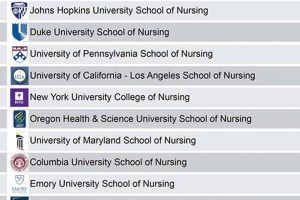Top-tier occupational therapy graduate programs offer advanced academic training and practical experience to prepare students for careers helping individuals of all ages participate in daily activities. These programs typically include coursework in areas such as anatomy, physiology, kinesiology, and therapeutic techniques, complemented by fieldwork in diverse clinical settings. Graduates often pursue licensure and certification, enabling them to work with clients facing physical, cognitive, or developmental challenges.
The quality of graduate education in occupational therapy directly impacts the competence and effectiveness of future practitioners. High-ranking programs contribute significantly to advancements in research, treatment methodologies, and assistive technologies. Historically, the profession has evolved from its roots in arts and crafts to a sophisticated field embracing evidence-based practice and cutting-edge interventions. Rigorous academic preparation within leading institutions is crucial for shaping future leaders and innovators within the profession.
Factors to consider when evaluating occupational therapy programs include faculty expertise, research opportunities, clinical affiliations, and student outcomes. Further exploration of these elements will provide prospective students with a comprehensive understanding of what constitutes excellence in occupational therapy education.
Tips for Selecting a Top Occupational Therapy Graduate Program
Choosing the right graduate program is a critical step towards a successful career in occupational therapy. Careful consideration of various factors can significantly impact future career opportunities and professional development.
Tip 1: Research Faculty Expertise: Investigate the faculty’s research interests, publications, and clinical specializations. A diverse and accomplished faculty can provide valuable mentorship and exposure to cutting-edge advancements in the field.
Tip 2: Evaluate Clinical Experiences: Examine the program’s clinical affiliations and the diversity of fieldwork opportunities offered. Robust clinical experiences are essential for developing practical skills and applying theoretical knowledge.
Tip 3: Consider Program Focus and Specializations: Reflect on individual career goals and explore programs that offer specializations aligned with those interests. Some programs may emphasize pediatrics, geriatrics, or specific therapeutic approaches.
Tip 4: Assess Research Opportunities: For those interested in research careers, investigate opportunities to participate in faculty research projects or pursue thesis options. Strong research programs can provide a foundation for future doctoral studies.
Tip 5: Explore Student Outcomes: Examine program data on licensure pass rates, graduation rates, and post-graduate employment statistics. These metrics offer insights into the program’s effectiveness in preparing graduates for successful careers.
Tip 6: Review Accreditation and Reputation: Ensure the program is accredited by the Accreditation Council for Occupational Therapy Education (ACOTE). Consider the program’s reputation among practitioners and within the academic community.
Tip 7: Analyze Program Costs and Financial Aid Options: Carefully evaluate the program’s tuition fees, living expenses, and available financial aid opportunities. Developing a realistic budget is essential for managing financial obligations during graduate study.
By carefully weighing these factors, prospective students can identify programs that best align with their individual aspirations and equip them for success in the dynamic field of occupational therapy.
Ultimately, the selection of a graduate program is a personal decision. Thorough research and thoughtful self-reflection are crucial for choosing the optimal path towards a fulfilling career.
1. Accreditation
Accreditation plays a crucial role in defining quality within occupational therapy education. Programs seeking accreditation undergo rigorous evaluation by the Accreditation Council for Occupational Therapy Education (ACOTE) to ensure they meet established standards for curriculum, faculty qualifications, clinical experiences, and student outcomes. This process signifies a commitment to excellence and provides prospective students with assurance that the program adheres to recognized benchmarks. For example, ACOTE accreditation verifies that a program provides sufficient fieldwork hours in diverse settings, preparing graduates for the complexities of practice. This external validation contributes significantly to a program’s reputation and standing among its peers.
The relationship between accreditation and program ranking is substantial. Top-tier occupational therapy programs consistently maintain ACOTE accreditation, demonstrating a dedication to upholding high educational standards. Accreditation status serves as a key indicator of program quality, influencing rankings and perceptions within the profession. Furthermore, graduation from an accredited program is often a prerequisite for licensure, highlighting the practical significance of accreditation for aspiring occupational therapists. For instance, a student graduating from a non-accredited program may face challenges obtaining licensure in certain states, limiting career opportunities.
In summary, accreditation is a critical factor to consider when evaluating occupational therapy programs. It represents a commitment to quality, influences program rankings, and has significant implications for licensure and career prospects. Prospective students are strongly encouraged to verify a program’s accreditation status before applying to ensure they invest in education that meets recognized professional standards. This informed decision-making empowers students to select programs that will effectively prepare them for successful careers in occupational therapy.
2. Faculty Expertise
Faculty expertise stands as a cornerstone of high-quality occupational therapy graduate programs. Distinguished faculty members contribute significantly to a program’s academic rigor, research opportunities, and overall prestige. Their knowledge, experience, and engagement shape the educational experience and prepare graduates for leadership roles within the profession.
- Scholarly Contributions and Recognition
Leading programs attract faculty who are actively engaged in research and scholarship. Publications in peer-reviewed journals, presentations at national conferences, and participation in grant-funded projects demonstrate a faculty member’s commitment to advancing the field. For example, faculty specializing in assistive technology might publish research on innovative device development, enhancing a program’s reputation for innovation.
- Clinical Specialization and Experience
Faculty with diverse clinical specializations enrich the learning environment by providing students with exposure to a wide range of practice areas. Experience working with specific populations, such as children with autism or adults recovering from stroke, allows faculty to share real-world insights and specialized knowledge. A program boasting faculty with varied clinical expertise can offer students more tailored mentorship and guidance based on individual career interests.
- Mentorship and Advising
Effective mentorship plays a critical role in student success. Faculty members in top programs provide individualized guidance to students, assisting with academic progress, career planning, and professional development. Strong mentorship fosters a supportive learning environment where students feel encouraged to explore their interests and reach their full potential.
- Professional Leadership and Service
Faculty involvement in professional organizations and leadership roles within the field demonstrates a commitment to advancing the profession and shaping its future. Active participation in organizations like the American Occupational Therapy Association (AOTA) allows faculty to stay abreast of current trends and advocate for the profession. This engagement translates into valuable insights and networking opportunities for students.
In summary, the collective expertise of the faculty significantly influences a program’s overall quality and contributes to its reputation as a leading institution for occupational therapy education. Prospective students should carefully evaluate faculty profiles when considering graduate programs, recognizing the profound impact faculty expertise has on their educational journey and future career prospects. A program with a distinguished faculty not only imparts knowledge but also cultivates critical thinking, fosters innovation, and prepares graduates for leadership roles within the dynamic field of occupational therapy.
3. Clinical Opportunities
Robust clinical opportunities represent a cornerstone of top-tier occupational therapy graduate programs. The quality, diversity, and structure of these experiences directly impact a student’s development into a competent and well-rounded practitioner. Leading programs prioritize providing students with immersive fieldwork experiences in a variety of settings, fostering the application of theoretical knowledge and the development of essential practical skills. For example, a program offering placements in both a traditional hospital rehabilitation setting and a community-based mental health clinic provides students with broader exposure to diverse client populations and practice contexts. This multifaceted approach to clinical education is a hallmark of excellence in occupational therapy training.
The depth and breadth of clinical experiences significantly influence program rankings and reputation. Accreditation bodies, such as the Accreditation Council for Occupational Therapy Education (ACOTE), place considerable emphasis on the quality and structure of fieldwork education. Programs that offer extensive and well-supervised clinical experiences in diverse settings are more likely to receive positive evaluations and maintain accreditation. Furthermore, employers often prioritize graduates with strong clinical backgrounds, recognizing the value of practical experience. A graduate who completed a rotation in a specialized pediatric clinic, for instance, might be more competitive for a pediatric occupational therapy position than a candidate with less focused clinical training.
In summary, the strength of clinical opportunities is a critical factor distinguishing leading occupational therapy graduate programs. These experiences are essential for translating academic knowledge into practical skills, fostering professional growth, and preparing graduates for the demands of contemporary practice. Prospective students should thoroughly investigate the types, duration, and supervision structure of fieldwork experiences offered by each program to make informed decisions aligned with career goals. A rigorous and diverse clinical curriculum not only strengthens a program’s reputation but also equips graduates with the competencies needed to thrive in a competitive healthcare landscape.
4. Research Facilities
Access to state-of-the-art research facilities significantly distinguishes top-tier occupational therapy graduate programs. These resources provide essential infrastructure for advancing knowledge, fostering innovation, and shaping the future of the profession. Dedicated research spaces equipped with specialized equipment, assistive technologies, and data analysis software empower faculty and students to engage in cutting-edge research. For example, a program with a dedicated biomechanics laboratory enables research on movement analysis and ergonomic design, contributing to evidence-based practice in areas like injury prevention and rehabilitation. The availability of such facilities enhances a program’s ability to attract competitive research grants, fostering a dynamic research environment.
The presence of advanced research facilities plays a crucial role in attracting and retaining high-caliber faculty and students. Established researchers seek environments conducive to conducting impactful studies, while prospective students are drawn to programs offering opportunities to participate in research projects and contribute to new discoveries. This symbiotic relationship between research infrastructure and academic talent strengthens a program’s reputation and elevates its standing within the field. For instance, a program with a well-equipped simulation center allows researchers to study the effectiveness of different interventions in a controlled environment, potentially leading to improved patient outcomes and influencing clinical practice guidelines.
In conclusion, the availability and quality of research facilities are integral components of leading occupational therapy graduate programs. These resources not only support faculty research endeavors but also provide invaluable training opportunities for students, fostering a culture of inquiry and innovation. Investment in research infrastructure directly contributes to a program’s ability to advance knowledge, attract top talent, and shape the future of occupational therapy practice. Ultimately, access to sophisticated research facilities elevates a program’s prestige and underscores its commitment to generating evidence-based solutions that improve the lives of individuals with diverse needs.
5. Curriculum Rigor
Curriculum rigor serves as a defining characteristic of top-tier occupational therapy graduate programs. A demanding and comprehensive curriculum equips students with the foundational knowledge, critical thinking skills, and advanced clinical reasoning abilities necessary for success in a complex and evolving healthcare landscape. Rigorous programs challenge students to delve deeply into the theoretical underpinnings of occupational therapy practice while simultaneously fostering the development of practical skills and professional competencies.
- Foundational Sciences and Theoretical Frameworks
Leading programs emphasize a strong foundation in biological, behavioral, and social sciences. Coursework in anatomy, physiology, kinesiology, and neuroscience provides essential knowledge for understanding human function and dysfunction. Theoretical frameworks, such as occupational science and models of human occupation, provide a conceptual lens for analyzing occupational performance and designing effective interventions. For example, in-depth study of neuroanatomy provides the basis for understanding the impact of neurological conditions on occupational performance.
- Advanced Clinical Skills and Practice
A rigorous curriculum progressively develops students’ clinical skills through a combination of didactic instruction, simulated learning experiences, and supervised fieldwork. Advanced coursework in areas like assessment, intervention planning, and assistive technology prepares students to address complex client needs. Opportunities to practice clinical reasoning and problem-solving in simulated settings, such as standardized patient encounters, bridge the gap between theory and practice. For instance, students might analyze case studies and develop individualized intervention plans based on client-centered principles.
- Research Methods and Evidence-Based Practice
Top programs cultivate research literacy and emphasize the integration of evidence-based practice into clinical decision-making. Coursework in research methods, statistics, and critical appraisal of research literature equips students to evaluate research findings and apply them to practice. Encouraging students to engage in research projects or participate in journal clubs fosters a culture of inquiry and prepares them to contribute to the advancement of the profession. Analyzing research articles on the effectiveness of different interventions, for example, strengthens students ability to make informed clinical decisions.
- Professional Development and Leadership
A comprehensive curriculum prepares graduates not only for entry-level practice but also for lifelong learning and professional leadership. Coursework in ethics, advocacy, and healthcare policy provides a broader context for understanding the role of occupational therapy in society. Opportunities to develop leadership skills through student organizations or community engagement initiatives prepare graduates to assume leadership roles within the profession and advocate for the needs of their clients. For instance, participation in a student-led advocacy project to improve accessibility in community spaces develops leadership skills and promotes professional identity.
In summary, curriculum rigor is a hallmark of excellence in occupational therapy graduate education. A demanding and comprehensive curriculum, encompassing foundational sciences, advanced clinical skills, research methodology, and professional development, prepares graduates to excel in a dynamic healthcare environment. Graduates of rigorous programs are equipped not only to provide high-quality client-centered care but also to contribute to the advancement of the profession through research, leadership, and advocacy. The depth and breadth of the curriculum ultimately distinguish the best graduate schools for occupational therapy and empower graduates to make meaningful contributions to the lives of individuals and communities.
6. Student Outcomes
Student outcomes serve as a critical indicator of quality and effectiveness within occupational therapy graduate programs. These outcomes reflect the program’s ability to prepare graduates for successful entry into the profession and continued professional growth. Top-tier programs consistently demonstrate strong student outcomes across various metrics, signifying a commitment to providing high-quality education and preparing graduates for the demands of contemporary practice. Analyzing student outcomes offers valuable insights for prospective students seeking programs that align with their career aspirations and maximize their potential for success.
- Licensure Examination Pass Rates
High licensure examination pass rates reflect a program’s effectiveness in preparing graduates for the National Board for Certification in Occupational Therapy (NBCOT) exam. Strong performance on this exam is essential for obtaining licensure and legally practicing occupational therapy. Programs with consistently high pass rates demonstrate a commitment to covering essential content and providing adequate preparation for this critical milestone. For example, a program boasting a 95% first-time pass rate on the NBCOT exam signals a strong track record of preparing graduates for licensure.
- Graduation and Completion Rates
Graduation and completion rates provide insight into a program’s ability to support students through the rigorous demands of graduate education. High graduation rates suggest that a program provides adequate academic and personal support to facilitate student success. These rates can also reflect the program’s admissions selectivity and the preparedness of incoming students. A program with a high graduation rate indicates an environment conducive to student learning and well-being.
- Post-Graduate Employment Rates
Post-graduate employment rates reflect a program’s success in preparing graduates for competitive career opportunities. High employment rates suggest that graduates possess the skills and knowledge sought by employers in various healthcare settings. These rates can also indicate the program’s connections with potential employers and the effectiveness of career services provided to students. For example, a program with a 90% employment rate within six months of graduation demonstrates strong preparation for career entry.
- Graduate School Placement
For students interested in pursuing doctoral degrees or specialized certifications, graduate school placement rates offer valuable insights. Programs that effectively prepare students for advanced study demonstrate a commitment to fostering intellectual curiosity and providing a strong foundation for continued academic pursuits. High placement rates in prestigious doctoral programs reflect positively on the quality of undergraduate education and the program’s ability to nurture future leaders in the field. A program with numerous graduates accepted into top-ranked doctoral programs signals strong academic preparation.
In summary, student outcomes offer valuable metrics for evaluating the quality and effectiveness of occupational therapy graduate programs. Strong performance across indicators like licensure pass rates, graduation rates, employment rates, and graduate school placement reflects a program’s commitment to preparing graduates for successful and fulfilling careers. Prospective students should carefully consider these outcomes when selecting a program, recognizing their significance in shaping future career trajectories and maximizing professional potential. Ultimately, strong student outcomes serve as a hallmark of excellence and distinguish the best graduate schools for occupational therapy.
Frequently Asked Questions about Top Occupational Therapy Programs
This section addresses common inquiries regarding the selection and pursuit of graduate education in occupational therapy.
Question 1: What distinguishes top-tier occupational therapy programs from others?
Key distinctions include faculty expertise, research opportunities, clinical affiliations, curriculum rigor, state-of-the-art facilities, and strong student outcomes. These factors contribute to a comprehensive educational experience that prepares graduates for success in the field.
Question 2: How does one evaluate the quality of clinical experiences offered by a program?
Evaluating clinical experiences involves considering the diversity of placement sites, the duration of fieldwork rotations, the level of supervision provided, and the opportunities for specialized practice experiences. A variety of settings, including hospitals, schools, and community centers, allows for broader exposure to diverse client populations and practice areas.
Question 3: What role does research play in occupational therapy graduate education?
Research plays a vital role in advancing the profession and informing evidence-based practice. Top programs offer opportunities for students to engage in research projects, collaborate with faculty on grant-funded studies, and contribute to the development of new interventions and assessments.
Question 4: How important is accreditation when choosing a program?
Accreditation by the Accreditation Council for Occupational Therapy Education (ACOTE) is essential. It signifies that a program meets established standards for quality and prepares graduates for licensure eligibility. Graduates of non-accredited programs may face challenges in obtaining licensure or securing employment.
Question 5: What factors should be considered when evaluating faculty expertise?
Evaluating faculty expertise involves reviewing their scholarly publications, research grants, clinical specializations, and professional leadership roles. Faculty with diverse backgrounds and active engagement in the field enrich the learning environment and provide valuable mentorship.
Question 6: How can prospective students assess the overall value and return on investment of a program?
Assessing value involves considering program costs, financial aid opportunities, student outcomes (e.g., licensure pass rates, employment rates), and career support services. A program’s value extends beyond financial considerations and encompasses the overall quality of education and career preparation provided.
Careful consideration of these frequently asked questions empowers prospective students to make informed decisions when selecting a graduate program that aligns with individual career goals and aspirations within the field of occupational therapy.
Further exploration of specific program websites and direct communication with admissions representatives can provide additional insights and assist in the decision-making process.
Best Graduate Schools for Occupational Therapy
Selecting among the best graduate schools for occupational therapy requires careful consideration of several key factors. Program accreditation, faculty expertise, clinical opportunities, research facilities, curriculum rigor, and student outcomes collectively shape the educational experience and influence future career trajectories. Thorough research into these aspects empowers prospective students to identify programs aligned with individual learning styles, career aspirations, and professional goals. A comprehensive understanding of these elements allows for informed decision-making and fosters a successful transition into the field of occupational therapy.
The pursuit of excellence in occupational therapy education represents an investment in the future of the profession. Graduates of top-tier programs are poised to become leaders, innovators, and advocates who shape the delivery of client-centered care and advance the field through research and scholarship. The demand for skilled and compassionate occupational therapists continues to grow, underscoring the importance of selecting a graduate program that provides a strong foundation for a rewarding and impactful career dedicated to improving the lives of individuals and communities.







